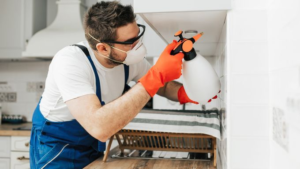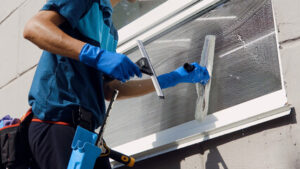Mice are rodents capable of chewing their way through support beams, rafters, and electrical wiring. They are also known carriers of several diseases that spread through contact with their urine, feces, or saliva.
Mice control begins with a thorough property inspection. Experts examine your home with surgical precision to identify entry points, nesting areas, and potential hotspots. Contact Mice Removal Service Texas now!

Mouse infestations are troublesome, dangerous, and costly. Their urine, saliva, and feces can spread diseases like salmonella and hantavirus, and their gnawing can cause serious damage to buildings. It is best to take action at the first sign of a problem. A small infestation can quickly grow into a massive one, as mice reproduce rapidly. The cost of extermination services increases with the size of the infestation and the number of entry points that need to be sealed.
Mouse pest control starts with a thorough inspection of the property. The technician will look for signs of activity, such as droppings, gnawed holes in walls and roof, and other indications that mice have been living in the house. He will also look for possible entry points for the mice, which are generally small cracks and gaps around doors, window frames, and baseboards. The technician may use caulk or other sealants to close these entry points.
If a large internal population of mice has been established, the technician will set traps throughout the house to eradicate them. These traps contain bait, such as peanut butter, bird seed, cheese, or other tasty treats that are designed to lure the mice into the trap. When the mouse enters the trap, it will be poisoned by the toxic substance. The trapped mice will then carry the bait back to its family members, which will be poisoned as well. This process is repeated until all the mice are eliminated from the home.
Bait stations can be used in addition to traps to prevent mice from returning to the home after the traps have been filled. These stations have a block of poison inside that is surrounded by an exterior barrier and can be placed near the areas where the mice are gaining access to your house. The mice will eat the bait and carry it to their own nests, where they will poison their family members as well.
Commercial properties that are plagued by mice need to have the problem taken care of as soon as it is detected. Mice can contaminate food supplies, and their constant gnawing can destroy furniture, wiring, and other valuables. The mouse pest control experts at Arrow Exterminating have the skills and tools needed to remove rodents from commercial properties quickly and effectively, minimizing the risk of contamination and damage.
Trapping
Mouse infestations can cause costly damage in hard-to-reach spaces like attics and basements, contaminating insulation, electrical wiring and storage areas. They also leave behind dangerous droppings and rodent urine and feces, which can carry disease-causing organisms. Fortunately, a reliable mice control service can help you get rid of them quickly and safely.
Mouse control begins with a thorough inspection of your property. Look for companies that emphasize eco-friendly and humane methods of pest eradication, especially those using integrated pest management (IPM) strategies. Avoid companies heavily reliant on harsh chemicals or pesticides, as these can be harmful to your family and pets.
Mice can squeeze their furry bodies through spaces the size of a dime, so the best way to prevent them is to seal any possible entry points into your home or business. Both inside and outside, install pipe collars wherever pipes enter your walls, door sweeps under doors, grates over drains and screens over vents. Regular inspections are important, as mice will be quick to find any gaps or cracks in which to slip through.
Depending on the extent of your mouse problem, your exterminator may recommend a specific treatment plan for your home or business. For instance, some companies use traditional snap traps, which are a quick and easy way to catch and kill mice. These traps are especially useful for attics and other places where kids and pets can’t reach. Others use glue traps that contain flat pads with glue, placed along mouse runways. Mice (and rats) run over the pads, getting stuck, which is considered inhumane.
Other signs of a mouse infestation include the appearance of droppings, which can be left anywhere the mice frequent, including the backs of drawers or pantries, the inside of cabinets and pantry shelves, basements or attic spaces, and under water heaters and heating units. You can also hear them scurrying or scratching at night.
Mouse infestations often involve more than just a single house, and if the population is well established, it may take some time to eliminate them. When choosing a pest control company, choose one that offers free inspections and flexible payment plans to make the process easier for you and your budget.
Sealing Entry Points
As a part of the pest control process, mice removal companies offer to seal all entry points that are discovered. This is especially important in older homes where the original mortar and stone foundation may have deteriorated over time, creating cracks and gaps. Mice are able to enter through these holes and create the conditions necessary for the infestations to flourish.
Mice have the ability to squeeze through gaps as small as a quarter inch. It is also important to remember that mice are naturally inquisitive creatures and will search for food sources and hiding places, even inside your home. If left unaddressed, a small mouse problem can turn into an infestation that poses significant health risks, as well as damage your property and possessions.
The first step in identifying and sealing these entry points is a complete inspection of both the interior and exterior of your house. This includes examining the kitchen area, baseboards, attic space, air vents and areas where pipes and utility lines are located. Mice have been known to enter through windows and doors that do not close properly, as well as attic openings that may allow them to access vents, chimneys and rooflines.
While it is possible that mice are gaining entry points into your house in locations you are unaware of, it is more likely that they are finding their way in through the most common places. These include doors that are not properly sealed or have door sweeps installed, window sills and vents. It is important to check these areas often and to keep them as clean as possible to deter mice.
Other ways mice are getting into homes is through leaking appliances and pipes, clogged gutters and crawlspaces. Cleaning cluttered areas, keeping trash in containers with tight lids and storing pet food in metal or glass bins will help to keep mice away from your property.
It is also a good idea to inspect the outside of your home for entry points on a regular basis, as weather changes can cause gaps and cracks to become larger. If a gap is missed and a mouse enters your home, it will only take a few weeks for the population to grow.
Prevention
If you want to avoid mice infestations, the best strategy is rodent exclusion. The professionals at a pest control company will identify all potential entry points and seal them to keep mice out of your Rochester home or business. They can also provide preventive treatments and recommend cleaning services to reduce places where mice like to hide.
Mice are capable of chewing through almost anything, including brick, to get inside a building. These critters also carry diseases and their droppings and saliva can contaminate food. This makes them a serious health concern for restaurants and other commercial facilities. In addition, their urine and feces create foul odors and can damage a building’s structure.
The first step in preventing mice is to do a walk-around of your home or business. Look for any cracks in the foundation and around pipes, gable vents and doors. Then, patch these areas with caulk or steel wool. You can also add door sweeps and repair any screens that have holes.
Other preventive measures include reducing clutter and storing food in rodent-proof containers. You should also clean up crumbs and spilled food regularly. Lastly, you should store wood piles away from your house and trim the surrounding vegetation.
During the initial visit, a professional will identify the source of the problem. They can then develop a plan to eradicate the mice and prevent them from returning. They may use traps, baits, rodenticides or other methods to get rid of the mice and prevent them from coming back.
Many pest control companies offer subscription plans for ongoing treatment. This helps you save money and ensures that the company will return on a regular basis. Before signing up for a plan, make sure to ask about their offered coverage and estimated pricing. This will allow you to compare plans and choose the one that’s right for your needs. Some companies also offer free inspections, which can help you determine the severity of your mouse infestation. Then, they can tailor their approach to your specific needs and budget.
